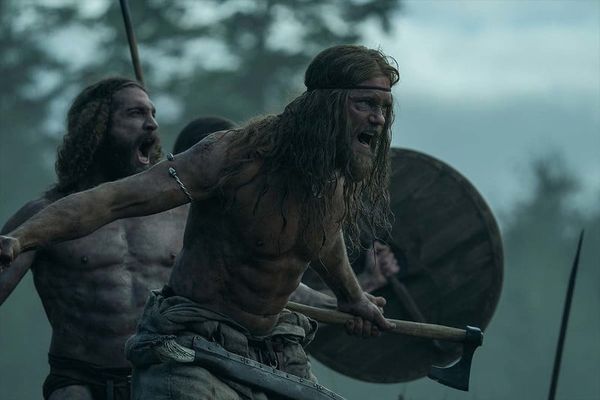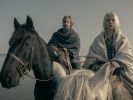Eye For Film >> Movies >> The Northman (2022) Film Review
The Northman
Reviewed by: Andrew Robertson

A kenning is a way of seeing. I indulge in a bit of linguistic trickery there, the word derived from roots that grow to the good Scots 'ken' of knowing but with tendrils that run to views at sea, something of the offing but the hazards of the coast. Director Robert Eggers gives us route to another tentacular connection, it is another term archaic for chalazae, the pair of spiralling connections that hold the yolk still within the shell. We perhaps most have kennings in sports now, football teams called by their stadia or for historic associations, though webbed wonders and caped crusaders keep them in their arsenal of identities.
The Northman is not his name, but it is a fair kenning. From the North, a man, of the North, of those peoples. We travel the whale road from the islands and forests and keeps and hills of Scandinavia, we follow the borderland of the fish trap into the lands of Rus, we pursue a vendetta into the grave valleys of Iceland. Alexander Skarsgård is Amleth, son of Stellan Skarsgård and also son of Aurvandil War-Raven (Ethan Hawke). To dip a further toe in the skies of mythology that name Aurvandil has flown in several skies, in its form of earendil it appears rarely in the Old English corpus. Perhaps cognate with the arrival of light, it with an umlaut is the name of the Half-elven son of Idril/Celebrindal and Tuor son of Huor, of the House of Hador, and father of Elros King of Numenor and Elrond Lord of Rivendell.

I mention The Lord Of The Rings because it is probable that you are more connected to that mythology by way of the skald Peter Jackson than to any epic or edda from which Tolkein drew. Though you might have noticed that with just a little rotation our protagonist Amleth becomes Hamlet, a pronunciation used in the film and undeniably inspiration for another magpie-muse, the upstart crow himself. There is a whole set of kings avenged of their jealous brother by their sons, but The Northman has not yet finished its raids upon the story cupboard.
Heimer The Fool (Willem Dafoe) makes a mock as jester in the court that later evidence reveals to be prophecy. One of dozens of roles that embrace if not duality then the fluidity of names and stations, he will reappear in the hands of the He-Witch (Ingvar Sigurdsson) in one of several sequences that are and are not of dreams. A legendarium that includes a return to film by Björk is no mean thing. Co-written by Eggers with Iceland's Sjon, a frequent collaborator of the electrical ululator it is only her second film after the traumas of Dancer In The Dark and one of those was with her then partner and still babydaddy visual artist Matthew Barney. There is a duel on the deck of a barrow-bound boat that minded me of Highlander not only for its level of magic but because The Kurgan drew his name from another form of tumulus.
Amleth's story differs from those of the various formations though, not least because of the other names he gives himself. A son of a warlike king, he is attended himself by ravens. Two fly over his father's wake-elk, and while they may not be Huginn and Muninn, their thought and memory attend across proceedings. Not only is there conflict between families but the gods. Not here the four-colours of Thor, where every outpost looks like a cross-franchise merchandise opportunity, but the aegis of the Aesir, resistant to the dead king of the southern people. Freyr and Odin, we're given a date to know we are past the synod of Whitby and know how far the Minsters of York and the Dane-law are working their angles in lands wester and easter. We're given a bloody glimpse that alludes to other myths, a creature somewhere between centaur and Sleipnir gives pause in an un-still morning.
Creature too elsewhere, for our Northman at one point guises himself as a bear and a wolf, this in a story where a feasting hall is besieged, where a monster's mother (Nicole Kidman) speaks with a honeyed tongue. My colleague noted that there are but nine years between Kidman and Skarsgard but there were just three between Angela Lansbury and Laurence Harvey in The Manchurian Candidate of 1962 and that discomfort was itself intentional. Claes Bang's Fjolnir The (eventually) Brotherless is himself but nine years older than Skarsgård, and at least some of these distortions come from that single rather than any other casting decision.
There are some giants here, of talent like Dafoe and Ethan Hawke, and physical. The Half-Troll, the Whale-Sided, Tooth-Gnasher and Giant-Crusher are all men who are easily looked up and at. There are melees aplenty, with some staggering violences done. A war-needle sown is reaped as a whirlwind, and the fish of attack are plentiful across the sea of wounds. One might quibble at the displays of horse-wealth, but stirrups got their foothold in Europe in the tracks of Viking raids so that is of surer step. The enclosure of strife is well done, the slaughter-gates are wielded as such for the most part, not the hack and chop of much stage combat but a fluid creation of space for strikes. Much as an attack upon the striped grass towards the onion bag is made of where the opponents are not, our understanding of sword and board is about binding and closing to invite wounds that need both.
Not all the fights, however. A climactic struggle under the pyroclastic lightnings and earthly shadow of an eruption volcanic recalls the fatherless Skywalker and his unready mentor. There the entreaty to "the high ground" was perhaps less a tactical observation than a diegetic realisation that the Force that moves through is not part of every living thing but of story. The clash of blades is here part of a different feedback loop, mounting that slope dark with foreboding and obsidian dust our revenger will pass two graves. I don't know if that constitutes a spoiler, I am relatively confident that even in a modern presentation the statute of limitation on some tales is shorter than millennia, indeed parts of The Northman are so riddled with history that, polyglot, they predate the English canon.
If this seems to be reading too much then perhaps it is. We are invited to, however, by intertitles, by the use of names and dates, by litanies. In acts of repetition, both on and of the screen we are shown threads and their weaving but can trace them back to other places. We have the tapes, try as some might to hide them. Comparisons to other pseudohistoric epics like Gladiator miss that this is a story informed by stories, we see in this tales told. Not lies, nor lionisation, but the touch of the Norns, the feats of the fates and the fell footsteps that follow them.
The Northman has a direction, Eggers again with collaborator Jarin Blaschke who lensed The Witch, The Lighthouse, shorts The Tell-Tale Heart and the less definite Brothers. By the light of the moon's wheel or the harm of the forest there is a grit and hue to proceedings. The fantastical is differently lit, the flicker of shadows in caves reaches some Platonic ideal distinct from the monochrome magics of distant lands. That the sky-road to Valhalla is shiny and chrome-bright is stretching things to their maximum, but that passage is one of many uncanny doings. Anya Taylor-Joy will be Furiosa we are told, but before then her turn as Olga of the Birch-Forest is one that grants her much room for mischief, for mystery. No stranger to black and white she is a fair and fabled counterpart in a story that may be eponymous but is not solely named.
My fondness for it does not blind me to its lackings. It is overlong, underlit or at least grim to the point of griminess. It does much to hide its literariness under a bushel, and though that's two kennings itself there are more than four pecks at the eye. It is raven-soaked, unshrinking from brutality though it hides some infanticide behind the six pack and change of Skarsgård's fortress of poetry. Its wicked kings and queens and princes verge on pantomime and a sporting sequence though tinged with tragedy seems a childish diversion, however near to danger the heir-bud of the usurper might have come. As tales themselves are so often revisited as this, perhaps a later cut will make this sharper. In his translation of the Beowulf Seamus Heaney used the word Damascene to describe a blade that was perhaps repurposed as much as it was worm-loop pattern inlaid, but as an arranger of the fjord of the gods his tools were less numerous and less expensive than those given to Eggers and his crew. The Northman charts a simple course, but one whose meanders hold meanings and whose eddies conceal eddas. If one is minded there is much to mind here. No straightforward text this, but one whose compass will needle for some time.
Reviewed on: 30 May 2022




















